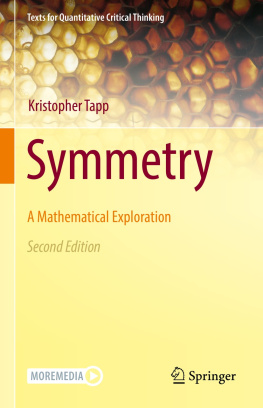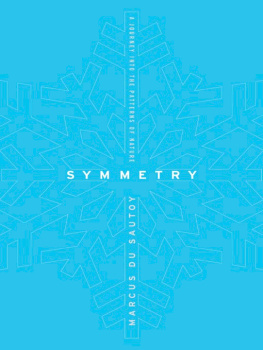
SIMON & SCHUSTER
Rockefeller Center
1230 Avenue of the Americas
New York, NY 10020
Copyright 2005 by Mario Livio
All rights reserved, including the right of reproduction in whole or in part in any form.
SIMON & SCHUSTER and colophon are registered trademarks of Simon & Schuster, Inc.
Designed by Paul Dippolito
Library of Congress Cataloging-in-Publication Data
Livio, Mario.
The equation that couldnt be solved:
how mathematical genius discovered the language of symmetry / Mario Livio.
p. cm.
Includes bibliographical references and index.
1. Group theoryHistory. 2. Galois theoryHistory.
3. Galois, Evariste, 18111832. 4. Symmetric functionsHistory.
5. SymmetryMathematicsHistory. 6. Diophantine analysisHistory.
I. Title.
QA174.2.L58 2005
512.209dc22 2005044123
ISBN-10: 0-7432-7462-8
ISBN-13: 978-0-7432-7462-3
Visit us on the World Wide Web:
http://www.SimonSays.com
To Sofie
Preface
Ever since my high school days I have been fascinated by variste Galois. The fact that a twenty-year-old could invent an exciting new branch of mathematics has been a source of true inspiration. By the end of my undergraduate years, however, the young French romantic had also become a source of deep frustration. What else can you feel when you realize that even by the age of twenty-three you have not accomplished anything of comparable magnitude? The concept introduced by Galois group theory is recognized today as the official language of all symmetries. And, since symmetry permeates disciplines ranging from the visual arts and music to psychology and the natural sciences, the significance of this language cannot be overemphasized.
The list of people who have contributed directly and indirectly to this book could in itself fill more than a few pages. Here I will only mention those without whose help I would have had a hard time completing the manuscript. I am grateful to Freeman Dyson, Ronen Plesser, Nathan Seiberg, Steven Weinberg, and Ed Witten for conversations on the role of symmetry in physics. Sir Michael Atiyah, Peter Neumann, Joseph Rotman, Ron Solomon, and especially Hillel Gauchman, provided insights and critical comments on mathematics in general and on Galois theory in particular. John OConnor and Edmund Robertson helped with the history of mathematics. Simon Conway Morris and David Perrett pointed me in the right direction in topics related to evolution and evolutionary psychology. I had fruitful discussions with Ellen Winner on the topic of creativity. Philippe Chaplain, Jean-Paul Auffray, and Norbert Verdier provided me with invaluable materials and information on Galois. Victor Liviot helped me to understand Galoiss autopsy report. Stefano Corazza, Carla Cacciari, and Letizia Stanghellini provided useful information on the mathematicians from Bologna. Ermanno Bianconi was equally helpful concerning the mathematicians from San Sepolcro. Laura Garbolino, Livia Giacardi, and Franco Pastrone provided me with essential materials on the history of mathematics. Patrizia Moscatelli and Biancastella Antonio provided important documents from the library of the University of Bologna. Arild Stubhaug helped me to understand some aspects of Niels Abels life and provided important documents, as did Yngvar Reichelt.
I am extremely grateful to Patrick Godon and Victor and Bernadette Liviot for their help with translations from French, to Tommy Wiklind and Theresa Wiegert for translations from Norwegian, and to Stefano Casertano, Nino Panagia, and Massimo Stiavelli for their assistance with translations from Italian and Latin. Elisabeth Fraser and Sarah Stevens-Rayburn provided me with invaluable bibliographic and linguistic help. The manuscript could not have been brought to print without the skillful preparation work by Sharon Toolan and the drawings by Krista Wildt.
The research and writing associated with a book of this scope put an inevitable burden on family life. Without the continuous support and infinite patience of my wife, Sofie, and my children, Sharon, Oren, and Maya, I could not have even dreamed of ever bringing the book to completion. I hope that my mother, Dorothy Livio, whose entire life has revolved and is still revolving around music, will enjoy this book on symmetry.
Finally, my sincere gratitude goes to my agent, Susan Rabiner, for her incredible work and encouragement, to my editor at Simon & Schuster, Bob Bender, for his professionalism and unrelenting support, and to Johanna Li, Loretta Denner, Victoria Meyer, and the entire team at Simon & Schuster for their help in producing and promoting this book.
A n inkblot on a piece of paper is not particularly attractive to the eye, but if you fold the paper before the ink dries, you may get something that looks like figure 1 that is much more intriguing. In fact, the interpretation of similar inkblots forms the basis for the famous Rorschach test developed in the 1920s by the Swiss psychiatrist Hermann Rorschach. The declared purpose of the test is to somehow elicit the hidden fears, wild fantasies, and deeper thoughts of the viewers interpreting the ambiguous shapes. The actual value of the test as an x-ray of the mind is vehemently debated in psychological circles. As Emory University psychologist Scott Lilienfeld once put it, Whose mind, that of the client or the examiner? Nevertheless, there is no denial of the fact that images such as that in figure 1 convey some sort of attractive and fascinating impression. Why?

Figure 1
Is it because the human body, most animals, and so many human artifacts possess a similar bilateral symmetry? And why do all those zoological features and creations of the human imagination exhibit such a symmetry in the first place?
Most people perceive harmonious compositions such as Botticellis Birth of Venus (figure 2) as symmetrical. Art historian Ernst H. Gombrich even notes that the liberties which Botticelli took with nature in order to achieve a graceful outline add to the beauty and harmony of the design. Yet mathematicians will tell you that the arrangements of colors forms in that painting are not symmetric at all in the mathematical sense. Conversely, most nonmathematical viewers do not perceive the pattern in figure 3 as symmetrical, even though it actually is symmetrical according to the formal mathematical definition. So what is symmetry really? What role, if any, does it play in perception? How is it related to our aesthetic sensibility? In the scientific realm, why has symmetry become such a pivotal concept in our ideas about the cosmos around us and in the fundamental theories attempting to explain it? Since symmetry spans such a wide range of disciplines, what language and what grammar do we use to describe and characterize symmetries and their attributes, and how was that universal language invented? On a lighter note, can symmetry provide an answer to the all-important question posed in the title of one of the songs of rock star Rod StewartDo Ya Think Im Sexy?

















